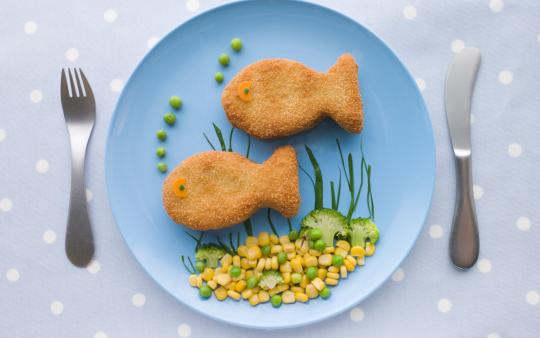Omega-3 fatty acids are essential for your child’s optimal health. It’s a nutrient that must be acquired and then synthesized through the ingestion and digestion of food and is found in rich supply in oily types of fish like salmon, sardines, or herring. While we grownups may look forward to a gorgeous cedar-planked salmon fillet or herring on toast, a lot of kids may feel strongly otherwise. Before you panic and try to sneak sardines into their breakfast smoothies, there are other ways to ensure that you’re still giving your kiddos the gift of omega-3 goodness!
Why are omega-3s important for kids?
Children need omega-3s in a fundamental way. The three types of fatty acids derived from them—ALA, EPA, and DHA—serve everything from cardiovascular health and cognitive function to reducing inflammation and depression. Deficiencies can manifest in signs like brittle nails or excessive ear wax, allergic conditions like eczema or asthma, or even behavioural issues.
Getting omega-3s into little bellies!
There’s nothing fishy about it: The best way to get enough omega-3 fatty acids into your child is to make sure they’re eating a well-balanced diet that includes two servings of fatty fish per week and a range of foods that captures all three acids. You can actually prevent picky eating starting as early as in utero! If your little one is just starting with solids, it’s not difficult (or too late!) to introduce fish into the mix so their palate develops an affinity for it.
Omega-3 essential fatty acid food sources
EPA and DHA are found in oily, cold water fish (cod liver, herring, mackerel, halibut, salmon, oysters and sardines), and edible algae. Grass-fed animal products also contain some amount of DHA.
ALA is found mostly in plant-based foods like nuts and seeds such as flax and chia seeds, walnuts, hemp, pumpkin, and soybeans.
If you’re struggling with an already picky toddler who refuses to eat fish, an adequate supply of ALA can help compensate for that, but it can’t happen without first ingesting ALA, which can then synthesize EPA, which in turn can be used to make DHA. The only caveat is that ALA-rich foods must be consumed more frequently than EPA/DHA-rich foods; this is because the conversion rate for the human body is relatively low. So, while two 3-ounce servings of fish a week provide sufficient EPA/DHA, at least five servings of flax seed (one tablespoon per serving) would be needed to generate adequate EPA and DHA. But there are a variety of ways to provide them.
- Mix an ounce of walnuts in with dried fruit and other nuts for an omega-rich trail mix.
- Toss some edamame with olive oil and a little sea salt and roast them for a tasty snack.
- Flax meal (ground flax) has a very subtle taste and incorporates well into many baked goods, so throw two tablespoons into your child’s favorite banana bread or carrot muffin to enrich their snack. Throw a tablespoon of flax meal or chia seeds into a smoothie, mix it into yogurt with fruit, or make a chia pudding or parfait.

Omega-3 supplements for kids
It is always best to get your nutrients straight from a whole food source, but supplementing may be indicated when this is challenging. There are many types of omega-3 supplements out there and a wide variety of oils (krill, algae, fish, and flax) are available in different forms—liquid, pills, and even gummies!—so you may need to experiment to find the best mode of delivery for your child.
Fatty acids are particularly sensitive to degradation if they are not stored at the proper temperatures and can be rendered anywhere from ineffective to rancid so look for a reputable source or facility that can guarantee the product has been properly stored. Look for products that are extracted from sustainably fished or wild-caught sources. The website Labdoor is a good source for identifying the quality of supplements, ranking them based on the accuracy of their labels, their efficacy, their purity, their nutritional value, and their safety. However, you should always discuss supplementing your child’s diet with a health provider knowledgeable about supplementation first.
Making sure your child gets all the nutrients they need to grow well is a real and eternal struggle, but it doesn’t have to be overwhelming. Remember that the healthy, whole foods you feed them also contain many other nutrients and benefits that cover so many of their other needs! If you start early to train their taste buds and prevent picky eating, and get creative to find foods they do love, you can rest easy knowing they’re thriving in health.
AN OMEGA-3 RECIPE THAT KIDS WILL LOVE!
This is a very simple, make-and-freeze recipe that provides lots of veggies and is a great example of how easily you can incorporate flax meal into any recipe.
Veggie Loaf with Flax Meal
Ingredients
- 2 cups spinach
- 1 cup broccoli florets
- 1 cup cauliflower florets
- 2 small carrots
- 2 small shallots
- 2-4 cloves garlic
- 2 tablespoons flax meal
- 2 teaspoons baking soda
- 1 1/2 cups of flour
- 1 teaspoon basil
- 1 teaspoon oregano
- salt & pepper
- 3 eggs
*Note: this recipe typically uses white flour but can be substituted with any alternative flour.
Instructions
- Preheat oven to 375º.
- Pulse the spinach, broccoli, cauliflower, carrots, shallots and garlic in a food processor until they are as fine as breadcrumbs.
- Mix the flax meal, baking soda, flour, basil, oregano, salt and pepper in a separate bowl and add the vegetables.
- Mix until all the vegetables are evenly coated with flour.
- Whisk the eggs in another bowl and add the vegetable mixture.
- Mix until it reaches a thick, paste-like consistency.
- Pour into a greased 9”x13” pan and spread so that it is evenly distributed.
- Bake for 30–40 minutes or until a toothpick comes out clean.
- Allow it to cool fully before slicing.






